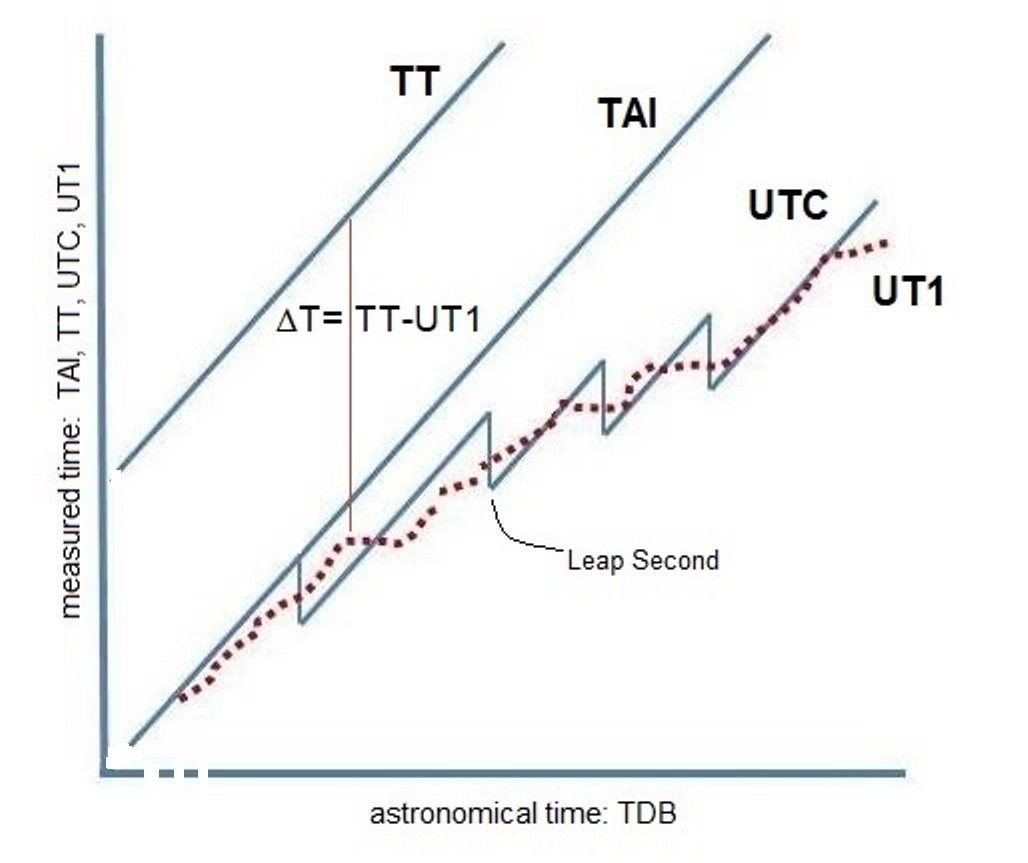Delta-T = TT−UT1 (V.04)
Author: H.Müller-Krumbhaar
Source: https://astro.ukho.gov.uk/nao/lvm/ (United Kingdom Hydrographic Office 2020). The difference between UTC (Universal Time Coordinated) and UT1 is max. ±0.9s, and can be ignored for most applications.
Enter YEAR (4 digits):
Result:
NOTE:
ΔT here is evaluated for UT1 january 1 each year. A value accurate to approx. ±1s is sufficient for most applications, so we do not discriminate between UT1 and UTC or variations over the year. Errors in ΔT have a much greater influence on the coordinates of the Moon than on the Planets. Note that by 2050 the uncertainty in ΔT is already about ±5s. ΔT is obtained through the following formula:
ΔT = 32.184s + (TAI−UTC) − (UT1−UTC)
Current values for TAI−UTC and UT1−UTC are regularly published on the web site of the International Earth Rotation and Reference Systems Service, IERS (IERS Bulletin A, General Information). Instead of UT1−UTC, here DUT1 (= UT1−UTC rounded to a precision of 0.1s) can be used. UTC deviates from UT1 by at most 0.9s because of the annual introduction of leap seconds into UTC.
Example (2020): TAI−UTC = 37s, DUT1 = −0.2s, ΔT = 32.184 + 37 − (−0.2) = 69.4s.
Timescales
Time historically was measured by some periodically returning natural event: day-night, summer-winter, full moon-new moon. Since the 18-th century sufficiently precise clocks - invented by John Harrison - replaced the pendulum-clocks and thus became useful on sea-going ships. Today we use quartz-watches and finally atomic-clocks. The time-unit "second" now is defined by 9.192.631.770 periods of an atomic resonance in Caesium-133 atoms. Important here is, that with the atomic-clocks (=timescale TAI) we have a time-piece, which does not depend upon the irregularities in the motion of celestial bodies. The frequencies of rotation of the earth around its axis or of the annual revolution of the earth as a whole around the sun are not constant over time. The earth rotation for example slows down, which increases the length of a day by about 18 microseconds per year on average within the last two-thousand years. ( See F.R.Stephenson, L.V.Morrison, C.Y.Hohenkerk (2016) in: https://royalsocietypublishing.org/doi/10.1098/rspa.2016.0404 .The long-time quadratic fit eq.(4.1) gives ΔT = -320+32.5*(( t[y]-1825)/100 )2 [s]. Taking the second time-derivative gives 32.5*2*10-4 [s/y]/y, or dividing by 365 [d/y]: ΔT=0.178*10-4 [s/d]/y. )

Fig.1 Timescales: TAI= TDB±1.7msec, TT=TAI+32.184s; UTC=TAI-Ninteger, UT1=TT-ΔT.
The timescales under consideration here are TAI (Temps Atomique International), TT (Terrestrial [Dynamical] Time), UTC (Universal Time Coordinated) and UT1 (Universal Time). TAI is the internationally averaged time over some 700 atomic-clocks, and is continuous. TT = TAI + 32.184s is practically the same as TAI but shifted, in order to match up to the previous Ephemeris Time. UTC and UT1 instead measure the rotation of the earth around its axis. UT1 measures directly the phase-angle of the rotating earth with respect to the direction towards the sun, which is a continuous measure. So a UT1-second, defined as 1/86400 of a day, differs slighlty from the definition of the second above and varies with time. With UTC we measure the same rotation, but by definition using the exact second. A day from noon to noon (=one earth rotation) then may not be exactly 86400 seconds long, measured by UTC. Therefore twice a year at end of june and december, there may be a leap-second added (or removed) on UTC, to keep the time-difference |UT1-UTC| < 0.9s. Over time these leap seconds add up, and so finally TAI differs from UTC by an integer number of leap seconds. Otherwise UTC is synchronous with TAI. As the earth rotation slows down on average, further leap-seconds between TAI and UTC must be introduced. The formula above then gives ΔT=32.184s + TAI - UTC - (UT1-UTC) = TT-UT1. The standard time-scale TDB (Temps Dynamique Barycentric), originally introduced by the NASA-Jet-Propulsion-Lab ("Horizons"-system), differs from TT by not more than 1.7 milliseconds, periodically. This takes into account relativistic corrections caused by gravitation and the varying speed of the earth in the solar system.
See also the useful web-site https://celnav.de by Henning Umland, to whom I am indebted for many helpful discussions and exchange of information.
######################### (last update: dec.2021) #################